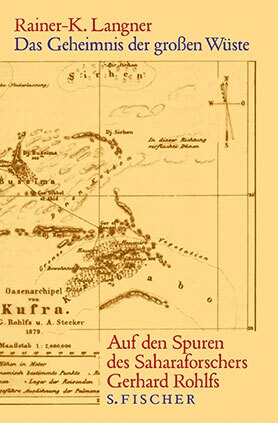Rainer-K. Langner
Das Geheimnis der großen Wüste. Auf den Spuren des Saharaforschers Gerhard Rohlfs
[The secret of the great desert. In the footsteps of the explorer of the Sahara Gerhard Rohlfs]
- S. Fischer Verlag
- Frankfurt am Main 2004
- ISBN 3-10-043930-9
- 302 Pages
- Publisher’s contact details
Rainer-K. Langner
Das Geheimnis der großen Wüste. Auf den Spuren des Saharaforschers Gerhard Rohlfs
[The secret of the great desert. In the footsteps of the explorer of the Sahara Gerhard Rohlfs]
Sample translations
Review
The African explorer Gerhard Rohlfs made a total of ten journeys between 1861 and 1885. Today his name may not be as familiar as those of his more famous colleagues Mungo Park, David Livingstone or Heinrich Barth and Gustav Nachtigall. In his own century, however, Gerhard Rohlfs was known as an adventurer, explorer and finally as envoy of the German Emperor on Zanzibar.
In his book Rainer-K. Langner fascinates the reader by his ability to combine Rohlfs’ life with an account of scientific practice and of the European view of the African continent. In those days there were still blank spots on the map of Africa, and many parts of the Sahara were unknown and mysterious to Europeans. The thought that North African peoples like the Tuareg, the Berbers or the numerous Arab tribes could have already uncovered these secrets centuries before, did not even occur to the self-confident Europeans with their belief in progress. Sustained by an unchallenged sense of superiority, an enterprising leader of an expedition like Gerhard Rohlfs, provided with sufficient financial resources, could become an “African explorer” without the least geographical or geological education.
Rohlfs had always been interested in military matters, and had already seen service with several armies and begun medical studies, before, at the age of thirty, he set out on his first journey into the desert. Together with a small group he travels through Morocco and crosses the Atlas Mountains. Since as a Christian he could expect to meet with disapproval and hostility, he disguises himself as a Muslim. More by chance than anything else he discovers that the Anti-Atlas forms a geographically distinct range. When he is almost killed because of his disguise, he only survives with the help of friendly desert inhabitants, who find and save him. After his return to Germany Rohlfs presents his notes to the most important geographer in the country, Heinrich Petermann, who recognises their value and is responsible for Rohlfs getting major recognition for the first time.
Instead, however, of telling the reader about the numerous adventurous journeys in chronological order, Langner addresses two other important subjects in his book: the Sahara Desert and the European attitude to the African continent and its inhabitants. Gerhard Rohlfs’ life only becomes properly comprehensible against this background, to say nothing of the extraordinary attraction, which the Sahara, this in every respect extreme landscape, held for him throughout his life.
In individual sections slipped into the development of the book Langner deals with various aspects like the origin and geological formations of the desert, meteorological peculiarities such as the winds and their effects on the landscape or the survival strategies of flora and fauna under such difficult climatic conditions. Today it’s almost become part of general knowledge, that under the Sahara there exists a vast reservoir of fossil ground water - modern methods of measurement and drilling have made the discovery possible. Yet not so long ago, the fact that as long ago as the 14th century deep artesian wells had been expanded, using slave labour, to create an extensive, effective water supply system, was quickly forgotten, once the French colonial power abolished slavery and the wells fell into disrepair.
This example reveals one of the outstanding features of this multi-layered book: Langner describes without judging. Gerhard Rohlfs, his “subject”, is a contradictory man, on the one hand utterly attached to the values of his continent, his religion and his century. He thinks himself cleverer and more civilised than the people he meets in Africa. As a “lord and master” he claims the right to keep a black boy, whose life he has saved, as a slave, to take him to Europe and there to give him to the king as a present. On the other hand, he is often not up to the conditions of the desert, has to break off expeditions prematurely, is defeated by problems which could have been overcome by the inhabitants of the desert without difficulty. In the field of politics, too, he sometimes lacks vision and he stumbles into a number of traps, set for him by local rulers. But unlike so many missing or murdered explorers Rohlfs always returns to Germany.
His striving for social acceptance and success also repeatedly comes into conflict with his almost childish search for adventure and discovery. Guided by obsessions he fails to carry out diplomatic missions and instead of going to the Congo basin travels into the Libyan desert. Nevertheless, finally Bismarck appoints him, in his capacity as an “Africa expert”, Consul General in Zanzibar. There he is supposed to explore by diplomatic means the potential for German interests in East Africa. But by this time Rohlfs has too much sympathy and understanding for the African population and consequently resists the unscrupulous methods of a Carl Peters, who in 1888 persuades the German Empire to take over as protecting power the estates he has illegitimately accumulated. Rohlfs opposition to Peters and to slavery soon leads to his recall.
It’s the combination of the three different kinds of account, the biographical, the geographical-geological and the historical-political which make the book so exciting and informative. It is much more than the biography of an extraordinary man. It describes the encounter between one cultural space and another, a “clash of cultures” in other words, which sometimes certainly brings to mind parallels with the present-day situation.

In his book Rainer-K. Langner fascinates the reader by his ability to combine Rohlfs’ life with an account of scientific practice and of the European view of the African continent. In those days there were still blank spots on the map of Africa, and many parts of the Sahara were unknown and mysterious to Europeans. The thought that North African peoples like the Tuareg, the Berbers or the numerous Arab tribes could have already uncovered these secrets centuries before, did not even occur to the self-confident Europeans with their belief in progress. Sustained by an unchallenged sense of superiority, an enterprising leader of an expedition like Gerhard Rohlfs, provided with sufficient financial resources, could become an “African explorer” without the least geographical or geological education.
Rohlfs had always been interested in military matters, and had already seen service with several armies and begun medical studies, before, at the age of thirty, he set out on his first journey into the desert. Together with a small group he travels through Morocco and crosses the Atlas Mountains. Since as a Christian he could expect to meet with disapproval and hostility, he disguises himself as a Muslim. More by chance than anything else he discovers that the Anti-Atlas forms a geographically distinct range. When he is almost killed because of his disguise, he only survives with the help of friendly desert inhabitants, who find and save him. After his return to Germany Rohlfs presents his notes to the most important geographer in the country, Heinrich Petermann, who recognises their value and is responsible for Rohlfs getting major recognition for the first time.
Instead, however, of telling the reader about the numerous adventurous journeys in chronological order, Langner addresses two other important subjects in his book: the Sahara Desert and the European attitude to the African continent and its inhabitants. Gerhard Rohlfs’ life only becomes properly comprehensible against this background, to say nothing of the extraordinary attraction, which the Sahara, this in every respect extreme landscape, held for him throughout his life.
In individual sections slipped into the development of the book Langner deals with various aspects like the origin and geological formations of the desert, meteorological peculiarities such as the winds and their effects on the landscape or the survival strategies of flora and fauna under such difficult climatic conditions. Today it’s almost become part of general knowledge, that under the Sahara there exists a vast reservoir of fossil ground water - modern methods of measurement and drilling have made the discovery possible. Yet not so long ago, the fact that as long ago as the 14th century deep artesian wells had been expanded, using slave labour, to create an extensive, effective water supply system, was quickly forgotten, once the French colonial power abolished slavery and the wells fell into disrepair.
This example reveals one of the outstanding features of this multi-layered book: Langner describes without judging. Gerhard Rohlfs, his “subject”, is a contradictory man, on the one hand utterly attached to the values of his continent, his religion and his century. He thinks himself cleverer and more civilised than the people he meets in Africa. As a “lord and master” he claims the right to keep a black boy, whose life he has saved, as a slave, to take him to Europe and there to give him to the king as a present. On the other hand, he is often not up to the conditions of the desert, has to break off expeditions prematurely, is defeated by problems which could have been overcome by the inhabitants of the desert without difficulty. In the field of politics, too, he sometimes lacks vision and he stumbles into a number of traps, set for him by local rulers. But unlike so many missing or murdered explorers Rohlfs always returns to Germany.
His striving for social acceptance and success also repeatedly comes into conflict with his almost childish search for adventure and discovery. Guided by obsessions he fails to carry out diplomatic missions and instead of going to the Congo basin travels into the Libyan desert. Nevertheless, finally Bismarck appoints him, in his capacity as an “Africa expert”, Consul General in Zanzibar. There he is supposed to explore by diplomatic means the potential for German interests in East Africa. But by this time Rohlfs has too much sympathy and understanding for the African population and consequently resists the unscrupulous methods of a Carl Peters, who in 1888 persuades the German Empire to take over as protecting power the estates he has illegitimately accumulated. Rohlfs opposition to Peters and to slavery soon leads to his recall.
It’s the combination of the three different kinds of account, the biographical, the geographical-geological and the historical-political which make the book so exciting and informative. It is much more than the biography of an extraordinary man. It describes the encounter between one cultural space and another, a “clash of cultures” in other words, which sometimes certainly brings to mind parallels with the present-day situation.
Translated by Martin Chalmers

By Heike Friesel
